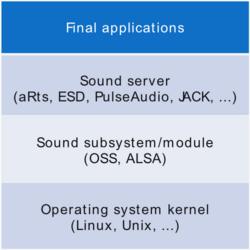Sound server
A sound server is software that manages the use of and access to audio devices (usually a sound card). It commonly runs as a background process.
Sound server in an operating system
In a Unix-like operating system, a sound server mixes different data streams (usually raw PCM audio) and sends out a single unified audio to an output device. The mixing is usually done by software, or by hardware if there is a supported sound card.
Layers
The "sound stack" can be visualized as follows, with programs in the upper layers calling elements in the lower layers:
- Applications (e.g. mp3 player, web video)
- Sound server (e.g. aRts, ESD, JACK, PulseAudio)
- Sound subsystem (described as kernel modules or drivers; e.g. OSS, ALSA)
- Operating system kernel (e.g. Linux, Unix)
Motivation
Sound servers appeared in Unix-like operating systems after limitations in Open Sound System were recognized. OSS is a basic sound interface that was incapable of playing multiple streams simultaneously, dealing with multiple sound cards, or streaming sound over the network.
A sound server can provide these features by running as a daemon. It receives calls from different programs and sound flows, mixes the streams, and sends raw audio out to the audio device.
With a sound server, users can also configure global and per-application sound preferences.
Diversification and problems
(As of 2012) there are multiple sound servers; some focus on providing very low latency, while others concentrate on features suitable for general desktop systems. While diversification allows a user to choose just the features that are important to a particular application, it also forces developers to accommodate these options by necessitating code that is compatible with the various sound servers available. Consequently, this variety has resulted in a desire for a standard API to unify efforts.
List of sound servers
- aRts
- Enlightened Sound Daemon
- JACK
- Network Audio System
- PipeWire
- PulseAudio
- sndio - OpenBSD audio and MIDI framework
Streaming
References
External links
 |


